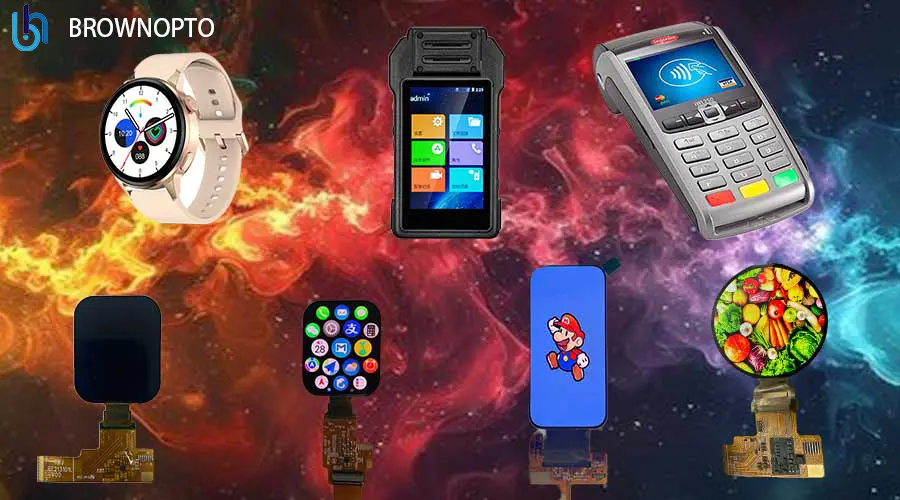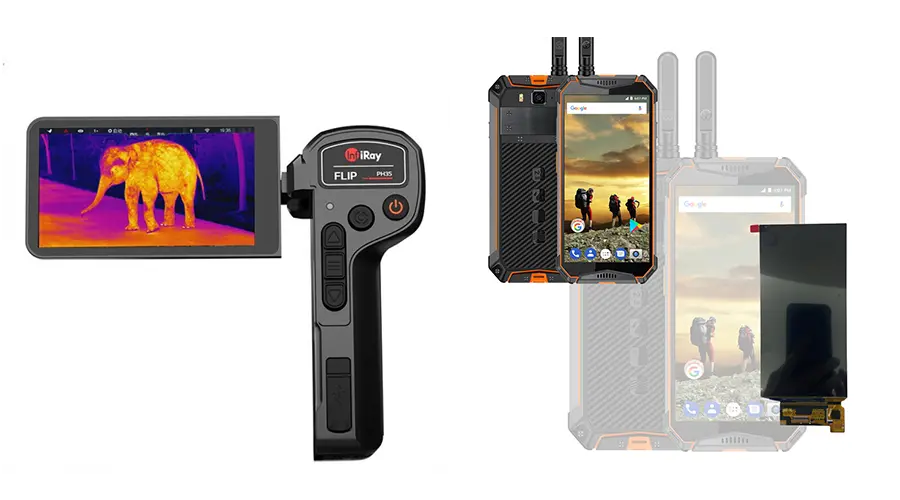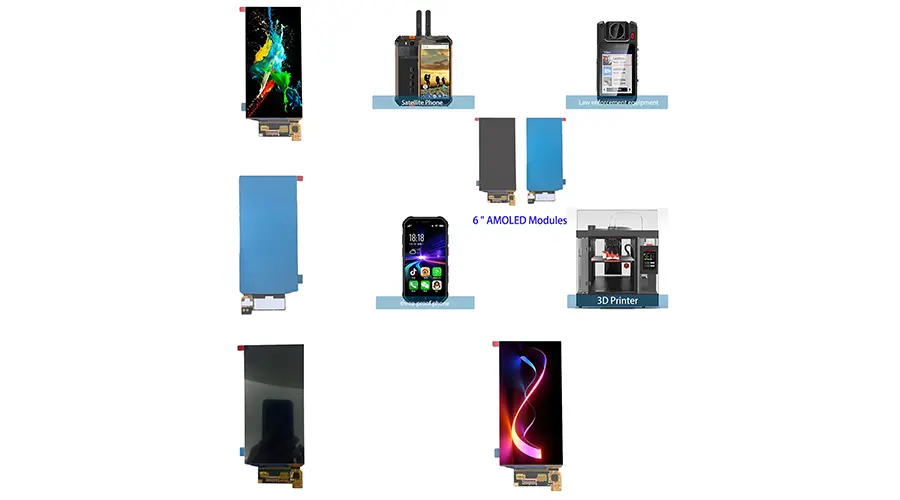A BROWNOPTO Engineering Case Study with MedTech Innovations Inc.
Klient: MedTech Innovations Inc. — a U.S.-based innovator in point-of-care (POC) diagnostic systems
Application: Portable Blood Chemistry Analyzer for Emergency & Rural Healthcare
BROWNOPTO Product: Custom 4.40" On-Cell Touch LTPS AMOLED Display Module (Model: BR440102-A1)
Interfejs: MIPI DSI 2-lane, 60Hz refresh rate
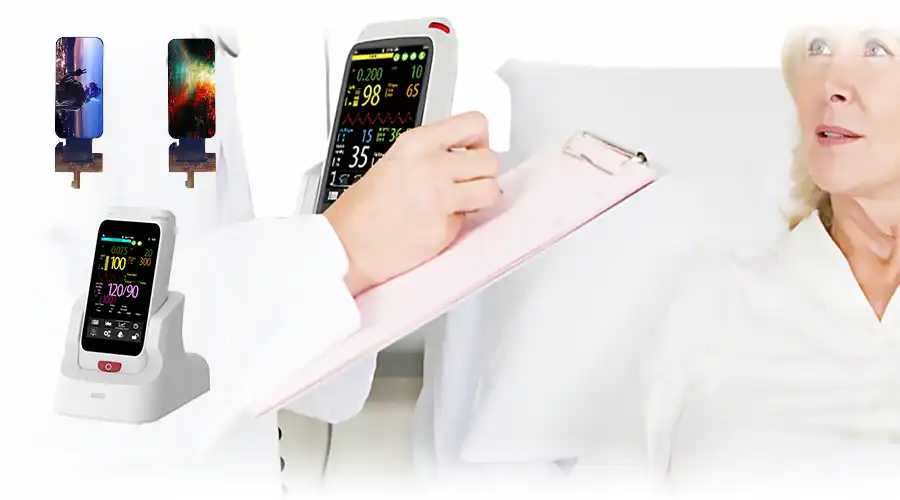
Project Background & Technical Challenges
Firma MedTech Innovations dążyła do zastąpienia tradycyjnego wyświetlacza LCD w swoim flagowym, przenośnym analizatorze krwi wyświetlaczem nowej generacji, który mógłby sprostać surowym wymaganiom środowisk klinicznych i terenowych. Urządzenie jest używane przez ratowników medycznych, techników laboratoryjnych i pracowników służby zdrowia na obszarach wiejskich – często w niekontrolowanych warunkach oświetlenia, temperatury i wilgotności.
Podstawowe wymagania dotyczące wyświetlania obejmowały:
Czytelność w świetle słonecznym:Jasność co najmniej 600 nitów z powłoką antyrefleksyjną (AR) gwarantuje czytelność w bezpośrednim świetle słonecznym (≥100 000 luksów).
Odporność na warunki środowiskowe:Stabilna praca w temperaturze otoczenia od -20°C do +70°C i przy wilgotności względnej 95% (bez kondensacji).
Czynniki ludzkie:Dotykowy ekran pojemnościowy, kompatybilny z rękawiczkami, z eliminacją dotyku mokrymi palcami i niskim opóźnieniem (<20 ms).
Współczynnik kształtu:Grubość modułu ≤0,8 mm pozwala na stworzenie cieńszej, bardziej ergonomicznej obudowy urządzenia przenośnego.
Zgodność z przepisami:Pełna zgodność z normami RoHS 2.0 (2015/863/UE), REACH (SVHC < 0,1%) i normami dotyczącymi materiałów bezhalogenowych (HF) w przypadku sprzętu medycznego.
Długoterminowa niezawodność:Ponad 50 000 godzin żywotności przy minimalnej degradacji jasności.
Gotowe panele AMOLED nie spełniały wymagań dotyczących wytrzymałości mechanicznej i spójności optycznej wymaganych dla urządzeń medycznych klasy II. MedTech potrzebował partnera w zakresie wyświetlaczy, który byłby w stanie współtworzyć te urządzenia, a nie tylko je dostarczać.
Współprojektowane rozwiązanie wyświetlacza AMOLED firmy BROWNOPTO
Firma BROWNOPTO uczestniczyła w 6-miesięcznym wspólnym programie rozwojowym z zespołami MedTech ds. sprzętu i oprogramowania układowego. Współpraca obejmowała projektowanie optyczne, integrację mechaniczną, walidację elektryczną oraz dokumentację regulacyjną.
Do kluczowych kamieni milowych inżynierii należą:
Optymalizacja stosu optycznego:Zastosowanie hybrydowego polaryzatora HC (Hard Coat) + AR w celu zmniejszenia odbicia powierzchni do <1,5% przy jednoczesnym zachowaniu odporności na zarysowania (twardość ołówka ≥3H).
Integracja dotyku na komórce:Dostosowano oprogramowanie układowe kontrolera dotykowego CST3530, aby obsługiwać wprowadzanie danych za pomocą 5-milimetrowych rękawiczek i zapobiegać fałszywym wyzwalaczom wywoływanym przez wilgoć lub kontakt z dłonią.
Zarządzanie ciepłem:Wdrożenie elastycznego obwodu drukowanego (FPC) o niskiej rozszerzalności cieplnej w celu zapobiegania rozwarstwianiu się podczas cykli termicznych.
Sekwencjonowanie mocy:Współtworzenie czasu włączania/wyłączania wyświetlacza we współpracy z PMIC firmy MedTech w celu wyeliminowania migotania ekranu podczas rozruchu.
Kalibracja kolorów:Kalibracja gamma i punktu bieli wykonywana fabrycznie (D65, gamma 2,2) w celu zapewnienia dokładnego wyświetlania elementów interfejsu użytkownika dla celów medycznych (np. ikon ostrzegawczych, wykresów trendów).
Dane techniczne
| Parametr | Specyfikacja | Standard walidacji |
|---|---|---|
| Typ wyświetlacza | 4,40" LTPS AMOLED | — |
| Obszar aktywny | 54,3 × 115,8 mm | — |
| Rezolucja | 568 × 1210 pikseli (Full HD+) | Gęstość pikseli: 296 PPI |
| Jasność | 600 nitów (typowo), 800 nitów (maksymalnie) | Zmierzone zgodnie z normą ISO 13406-2 |
| Współczynnik kontrastu | 100 000:1 (typowo) | Nieskończoność w ciemnych warunkach |
| Technologia dotykowa | Pojemnościowy na ogniwie (CST3530 IC) | Obsługuje 10-punktowy multidotyk |
| Kąt widzenia | ≥85° (we wszystkich kierunkach) | ΔE < 5 przy 80° |
| Grubość modułu | 0,75 mm (bez FPC) | — |
| Interfejs | MIPI DSI 2-pasmowy, 60 Hz | Zgodny z MIPI Alliance v1.3 |
| Temperatura pracy | -20°C do +70°C | IEC 60068-2-1 / -2-2 |
| Temperatura przechowywania | -30°C do +80°C | — |
| Zgodność | RoHS 2.0, REACH, HF, ISO 10993-5 (testowane pod kątem cytotoksyczności) | Pełna deklaracja materiałowa dostępna |
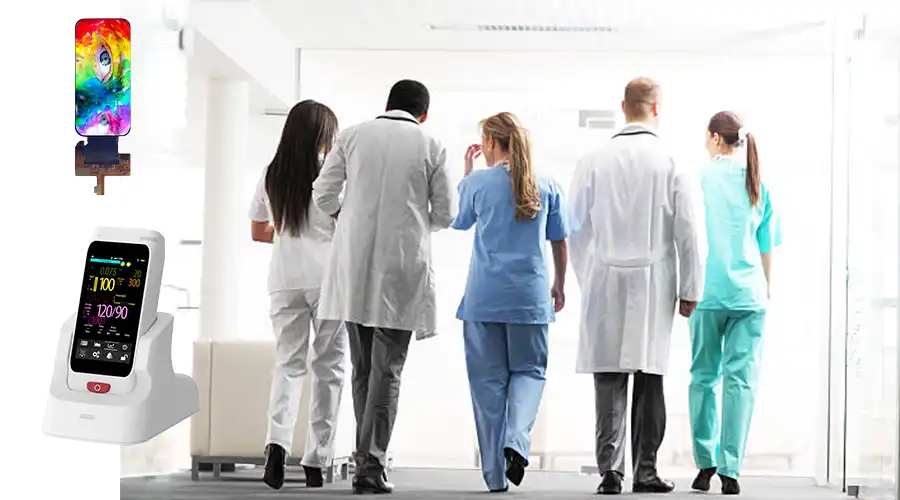
Validation & Field Performance
Moduł BR440102-A1 przeszedł rygorystyczną walidację w ośrodkach BROWNOPTO i MedTech:
Badania środowiskowe:Przeszedł 240-godzinny cykl wysokich/niskich temperatur (-20°C ↔ +70°C) i 96-godzinną ekspozycję na wilgotność względną 95% bez rozwarstwienia lub murawy.
Wytrzymałość mechaniczna:Przetrwał 3 upadki z wysokości 1,2 m na sklejkę (zgodnie z normą IEC 60601-1-11) bez żadnych usterek funkcjonalnych.
Spójność optyczna:Jednorodność jasności >85% na całym panelu; przesunięcie koloru (Δu'v') < 0,01 przy zmianie kąta patrzenia.
Pilot kliniczny:Rozwiązanie wdrożono w 500 jednostkach w 12 agencjach amerykańskiej służby ratownictwa medycznego (EMS) w ciągu 12 miesięcy — nie odnotowano żadnych usterek związanych z wyświetlaczami.
„BROWNOPTO nie tylko dostarczyło wyświetlacz – firma włączyła się w nasz proces NPI. Ich zespół inżynierów rozwiązał problemy z hałasem dotyku, z którymi zmagaliśmy się od miesięcy, i zadbał o to, aby AMOLED spełniał wymogi FDA dotyczące identyfikowalności materiałów. Ta współpraca odegrała kluczową rolę w wprowadzeniu naszego produktu na rynek”.
— Główny inżynier systemów sprzętowych, MedTech Innovations Inc.
Dlaczego wyświetlacze BROWNOPTO AMOLED sprawdzają się w zastosowaniach medycznych
Podejście BROWNOPTO wykracza poza dostawę komponentów. Oferujemy kompleksowe projektowanie wyświetlaczy dla aplikacji o znaczeniu krytycznym:
Projektowanie zorientowane na aplikację:Wyświetlacze zaprojektowane do użytku w rzeczywistych warunkach, a nie tylko zgodnie ze specyfikacjami katalogowymi.
Integracja pionowa:Własne powłoki optyczne, integracja dotykowa i testy niezawodności.
Wsparcie regulacyjne:Pełna dokumentacja zgodności materiałów (RoHS, REACH, HF, ISO 10993) w przypadku przesyłek dotyczących wyrobów medycznych.
Skalowalny NPI:Od prototypu do produkcji masowej z zachowaniem stałej jakości (PPM < 50).
Wsparcie globalne:Zespoły inżynierów w Azji, Ameryce Północnej i Europie zapewniające szybką reakcję.
Chcesz zintegrować niezawodny wyświetlacz AMOLED ze swoim urządzeniem medycznym, przemysłowym lub obronnym?
Skontaktuj się z BROWNOPTOaby uzyskać konsultację dotyczącą niestandardowego wyświetlacza — zaprojektowanego z myślą o wydajności, zbudowanego z myślą o niezawodności.
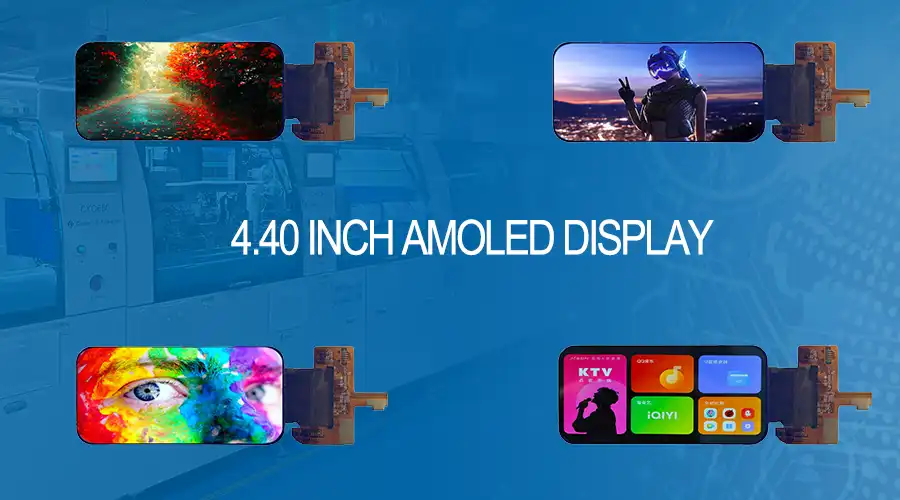
Często zadawane pytania
Co jest przyczyną wypalania się wyświetlaczy OLED i jak temu zapobiec?
Wypalenie występuje, gdy materiały organiczne ulegają nierównomiernej degradacji w wyniku długotrwałego wyświetlania statycznych obrazów. Zapobieganie obejmuje stosowanie automatycznego przyciemniania, wygaszania ekranu, przesunięcia pikseli, przyciemniania logo oraz unikanie wysokiej jasności w przypadku treści statycznych.
Czy wyświetlacze OLED nadają się do stosowania na zewnątrz lub w miejscach o dużej jasności?
Standardowe diody OLED słabo radzą sobie w bezpośrednim świetle słonecznym ze względu na ograniczoną jasność szczytową. Niektóre modele charakteryzują się jednak wyższą jasnością i powłokami antyrefleksyjnymi. Do użytku na zewnątrz warto rozważyć zastosowanie diod Mini-LED lub specjalistycznych wariantów OLED o wysokiej jasności.
Jak długo zazwyczaj działają wyświetlacze OLED?
Żywotność wyświetlaczy OLED wynosi zazwyczaj od 30 000 do 100 000 godzin przy jasności L50 (połowa jasności). Żywotność zależy od sposobu użytkowania, poziomu jasności i temperatury pracy. Niebieskie piksele ulegają szybszej degradacji, dlatego balans bieli może z czasem ulegać zmianie.
Czy diody OLED można stosować w wyświetlaczach stale włączonych (AOD)?
Tak — wyświetlacze OLED idealnie nadają się do AOD ze względu na niskie zużycie energii podczas wyświetlania ciemnych motywów lub małych ikon. Aby zmniejszyć ryzyko wypalenia, należy stosować dynamiczne pozycjonowanie, niską jasność i ograniczać liczbę aktywnych pikseli.
Jaka jest różnica między AMOLED i PMOLED?
AMOLED (Active Matrix OLED) wykorzystuje płytę główną TFT, co zapewnia szybkie odświeżanie obrazu i wysoką rozdzielczość, idealną do smartfonów i urządzeń noszonych. PMOLED (Passive Matrix OLED) steruje bezpośrednio rzędami/kolumnami, co jest odpowiednie dla mniejszych, prostszych wyświetlaczy o niższym koszcie.
Czy wyświetlacze OLED obsługują funkcję dotykową?
Tak — większość modułów OLED integruje pojemnościowe (PCAP) lub rezystancyjne warstwy dotykowe. Elastyczne OLED-y często łączą się z zakrzywionymi czujnikami dotykowymi, tworząc bezproblemowe konstrukcje urządzeń noszonych i samochodowych.
Najnowsze artykuły
-
Dlaczego 1–2-calowe wyświetlacze AMOLED są kluczowe dla AR/XR w 2025 roku
Dlaczego wyświetlacze AMOLED o przekątnej 1–2 cali stają się niezbędne w boomie AR/XR (wgląd w branżę w 2025 r.)
-
Understanding OLED Display Technology: Principles, Performance & Applications
OLED (Organic Light Emitting Diode) displays are a class of self-emissive display technology in whic
-
From Wearables to AR Glasses – How OLED Displays Are Redefining Visual Experiences in 2025
By 2025, OLED (Organic Light-Emitting Diode) technology has transitioned from luxury smartphone disp
-
Wyświetlacze LCD z rozciągniętymi paskami do sprzedaży detalicznej: Zwiększ sprzedaż i zaangażowanie w supermarketach
Odkryj, jak wyświetlacze LCD z rozciągniętymi paskami zwiększają sprzedaż na półkach supermarketów, zwiększają sprzedaż i obniżają koszty
-
Rozciągnięte rozwiązania LCD dla restauracji i obiektów gastronomicznych
Rozciągnięte wyświetlacze LCD oferują eleganckie, jasne wyświetlacze, idealne do menu w restauracjach i hotelarstwie.

